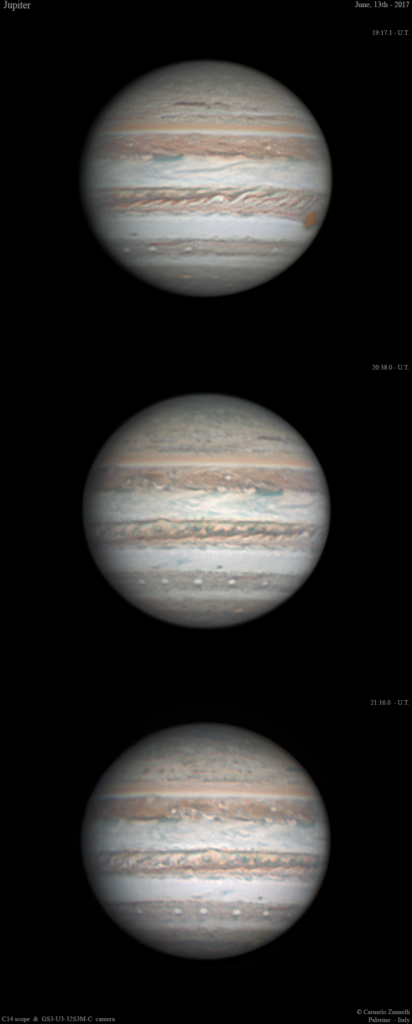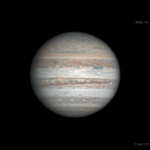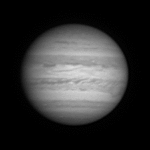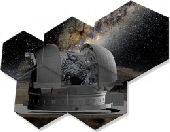Italiano:
Eccovi una ripresa del gigante gassoso Giove, datata 13 giugno scorso, in una serata di seeing accettabile (6,5 – 7/10 nel canale Rosso a circa 600 nm), che ritrae Giove in tre differenti momenti e longitudini della sua veloce rotazione sul proprio asse, che avviene mediamente in circa 9h 55min.
Nella prima immagine, la Grande macchia Rossa sta tramontando dal nostro punto di vista Terrestre mentre diversi vortici e fratture complesse sono visibili sia nella NEB (Banda Equatoriale Nord) che nella SEB (Banda Equatoriale Sud).
Nella seconda e terza immagine, sono evidenti i numerosi WOS (White Oval Spot) cioè macchie ovali bianche, piccoli vortici anticiclonici ad alte latitudini Sud (ricordo che in queste immagini il Sud è in basso), mentre il cosidetto STB Spectre (il residuo di Banda Temperata Sud) transita al meridiano.
Aggiungo anche una gif animata che mostra tutta la durata delle riprese nel canale Rosso, a circa 600nm, dove i dettagli ripresi sono un po’ più evidenti.
Le calde serate di questo mese di giugno – che ci ha dato una estate anticipata -, benchè caratterizzate da alta pressione duratura e stabile, sono pervase anche da un eccessivo calore accumulato durante il giorno che si traduce in escursioni termiche notturne locali che impediscono, benchè alle alte quote i jetstreams fossero abbastanza stabili, una stabilità atmosferica ottimale, più caratteristica dei periodi primaverili o autunnali.
Questo impedisce di ottenere immagini in alta risoluzione ottimali, soprattutto alle lunghezze d’onda medio basse tipiche dei colori Verde e soprattutto Blu, utilizzati nelle riprese astronomiche planetarie. Solitamente la lunghezza d’onda del canale Rosso, a circa 600nm, a Palermo risulta quasi sempre sufficientemente stabile, ma nella composizione delle tricromìe, costituite anche da Verde e Blu, il risultato viene poi degradato.
Dettagli tecnici: Celestron C14 StarBright ad F/27 – Baader-Zeiss barlow lens – Baader RGB filter set – PointGrey GS3-U3-32S4M-C camera – Seeing 6,5 – 7/10 in R band (~ 600nm) – sito: Palermo centro @ my personal Observatory
English:
Here is a session of Jupiter, dated June 13th, on a decent evening (6,5 – 7/10 in the Red Channel at about 600 nm), which portrays Jupiter in three different moments of longitudes.
In the first image, the Great Red Spot is setting off from our Earthly point of view, while several vortices and complex rifts are visible both in the NEB (North Equatorial Banda) and SEB (South Equatorial Band).
In the second and third images, there are numerous WOS (White Oval Spot), while the so-called STB Spectre (South West Banda) passes to the Central Meridian.
I also add an animated gif that shows the entire duration of the shooting in the Red Channel, about 600nm, where the details are a bit more noticeable.
The warm evenings of this month of June – which gave us an early summer – although characterized by high and steady high pressure, was also overwhelmed by excessive heat accumulated during the day which translates into local night-time thermal excursions that prevent, though at high altitudes jetstreams were quite stable, optimum atmospheric stability, more characteristic of spring or autumn periods.
This prevents me from obtaining really high-resolution images, especially at low mid-wavelengths typical of Green and Blue lights.
Usually the wavelength of the Red Channel, at about 600nm, is almost always sufficiently stable in Palermo, but in the composition of the trichromy, the result is then degraded.
Thanks for your attention!
Technical details: Celestron C14 StarBright ad F/27 – Baader-Zeiss barlow lens – Baader RGB filter set – PointGrey GS3-U3-32S4M-C camera – Seeing 6,5 – 7/10 in R band (~ 600nm) – site: Palermo city @ my personal Observatory



